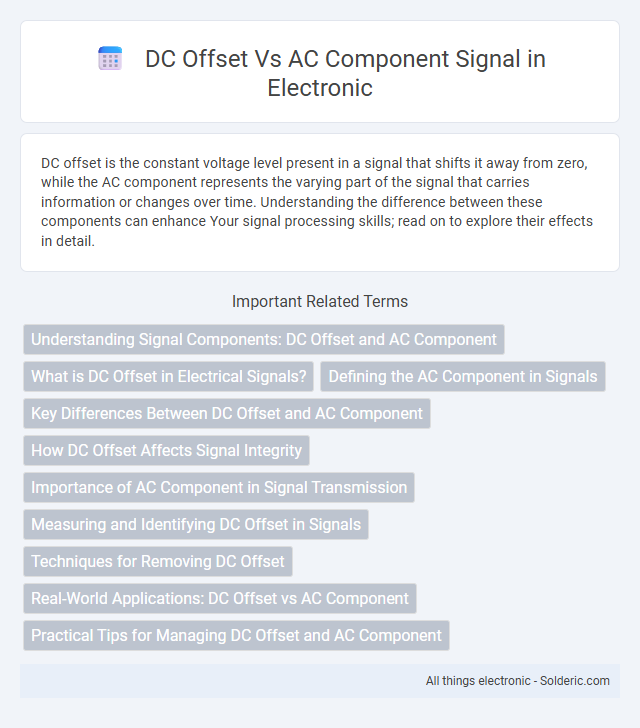DC offset is the constant voltage level present in a signal that shifts it away from zero, while the AC component represents the varying part of the signal that carries information or changes over time. Understanding the difference between these components can enhance Your signal processing skills; read on to explore their effects in detail.
Comparison Table
| Feature | DC Offset | AC Component |
|---|---|---|
| Definition | Constant voltage or current added to a signal | Time-varying portion of a signal around zero volts |
| Frequency | 0 Hz (steady state) | Above 0 Hz (variable frequency) |
| Signal Behavior | Shifts signal baseline up or down | Represents signal fluctuations or variations |
| Effect on Signal | May cause measurement errors or saturation | Contains useful information such as modulation or oscillation |
| Removal Method | High-pass filtering or capacitive coupling | Low-pass filtering isolates it from noise |
| Application | Biasing electronic components | Signal processing, communication, and measurements |
Understanding Signal Components: DC Offset and AC Component
Signal analysis differentiates between DC offset, the constant voltage level shifting the entire waveform, and the AC component, which represents the fluctuating part of the signal around that baseline. DC offset affects signal integrity by introducing a steady bias, often requiring removal for accurate measurement or processing. The AC component contains the essential varying information, crucial for tasks like audio processing, communications, and sensor data analysis.
What is DC Offset in Electrical Signals?
DC offset in electrical signals refers to a constant voltage level added to an alternating signal, shifting its baseline away from zero volts. This offset can cause distortion in signal processing and affect the operation of electronic devices by introducing unwanted bias. Understanding and minimizing DC offset is crucial for maintaining signal integrity and ensuring accurate measurements in Your electronic systems.
Defining the AC Component in Signals
The AC component in signals refers to the varying part of a signal that oscillates above and below a zero voltage reference point, representing changes over time. DC offset is the constant voltage level shift that moves the entire signal away from zero, while the AC component captures the actual information or variations within the signal. Your analysis of signal behavior improves by isolating the AC component, enabling accurate interpretation of changes without interference from the DC offset.
Key Differences Between DC Offset and AC Component
The DC offset in a signal represents a constant voltage level that shifts the entire waveform above or below zero volts, while the AC component fluctuates around the zero point, carrying the varying information or signal changes. DC offset affects signal accuracy by introducing a bias that can distort measurements or processing, whereas the AC component is essential for transmitting information through time-varying changes. Understanding the distinction helps you optimize signal processing tasks by ensuring correct filtering and interpretation of both steady-state and varying elements in your data.
How DC Offset Affects Signal Integrity
DC offset in a signal causes a constant voltage shift that can distort the true representation of the AC component, leading to inaccurate signal analysis and measurement errors. This voltage shift may saturate amplifiers or reduce dynamic range, degrading overall signal integrity and making it harder to recover the original information. Understanding and minimizing DC offset is critical to preserving the fidelity of your signal and ensuring precise electronic communication or data acquisition.
Importance of AC Component in Signal Transmission
The AC component in signal transmission is crucial because it carries the actual information or data, while the DC offset represents a constant voltage level that does not convey useful signal variations. Accurate detection and processing of the AC component ensure signal integrity, enabling effective communication and data transfer in electronics and telecommunication systems. Your receivers must filter out DC offset to avoid distortion and maintain the fidelity of the transmitted AC signal.
Measuring and Identifying DC Offset in Signals
Measuring and identifying DC offset in signals involves analyzing the waveform to detect any constant voltage shift from zero baseline, which can distort true signal interpretation. Using instruments like oscilloscopes or digital multimeters, you can quantify the DC offset by observing the average voltage level over time, distinguishing it from the AC component that represents the varying signal part. Proper identification of the DC offset in your signals ensures accurate measurement and effective signal processing, preventing potential errors in communication or electronic circuits.
Techniques for Removing DC Offset
Techniques for removing DC offset in signals primarily include high-pass filtering, which effectively blocks the DC component while allowing AC signals to pass. Capacitive coupling also serves to eliminate DC offset by blocking constant voltage levels and transmitting only fluctuating signals. Using these methods ensures your signal processing maintains accuracy by focusing on the AC component and minimizing distortion caused by offset voltage.
Real-World Applications: DC Offset vs AC Component
In real-world applications, DC offset signals are crucial for biasing electronic circuits, ensuring proper operation in devices like amplifiers and sensors, while AC components represent varying signals important in communication systems and audio processing. Understanding the difference between DC offset and AC signals helps you design circuits that can filter unwanted noise or maintain signal integrity in power supplies and instrumentation. Effective handling of DC offset and AC components ensures accurate data transmission, stable operation of electronic devices, and improved performance in signal processing scenarios.
Practical Tips for Managing DC Offset and AC Component
To manage DC offset in signal processing, use coupling capacitors or high-pass filters to block undesirable DC voltage while preserving the AC component. Calibration of measurement instruments and regular zero adjustment help reduce DC offset errors, enhancing signal accuracy. For AC component optimization, ensure proper impedance matching and use shielded cables to minimize noise and distortion in audio and communication systems.
DC offset vs AC component signal Infographic

 solderic.com
solderic.com